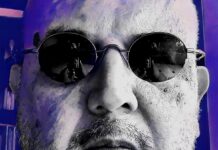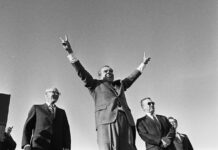What Is a Poem? Not Sure. But Let Me Count the Ways
One of the best lessons I have learned as a writer of poems is to know when to stop asking what a poem is. Trying to find the definition of “poem” inevitably fails as an intellectual pursuit because of the nature of language and definition. Literary theorists of all stripes have at least offered one sure piece of wisdom: to define anything requires words borrowed from other definitions made up of words ad infinitum. Although there are different names for this theory and different implications coming from different philosophers, you need only flip through a dictionary to see its truth. Because poems––and this is not a definition––are human monuments to the humanity of human language, one can begin to see that poems are better defined in the practice of poetry. Any ruminative pursuit about what poetry is will only lead us back to poetic language.
As helpless as it sounds, it is no less imperative to ask what a poem is. Every poet knows this imperative as soon as he or she sits at the desk to write a poem. Is this idea, this color, this cadence, line, metaphor, this musical itch I have to write on a page the stuff of a poem? At that point, the poet goes into the far reaches of their poetic tradition as imputed into the recesses of their mind for a working set of concepts-–none definitive––to help them turn their strange linguistic urge into a poem. Looking back at how poems have been defined before, both in theory and in practice, helps the poet make his or her contribution either in deviation from or within the permeable boundaries of poetic tradition.
One sure way to look back to the tradition for key ideas about poetry is looking to the origins of a language itself. As a writer of poetry in English, it is useful to look far back to its elastic and absorptive origins. For now, I can offer a brief, grossly simplified, linguistic history: English began as an Indo-European language of West Germanic descent, or what is also called Low German. Because it was spoken by the Angle and Saxon tribes, the language became known and was characterized by hard, heavily accented monosyllabic Germanic words. This was spoken in what became England until the Norman Invasion of 1066, which introduced Old French, a Romance language with multi-syllabic words, to Anglo-Saxon, and resulted in what we now know as Old English. The marriage of disparate linguistic origins (the Low Germanic with the Latinate Old French) resulted in the English we speak today, which possesses the largest vocabulary in the world. The sonic characteristics of each linguistic root is classed so that the hard, monosyllabic Anglo-Saxon words that remained were mostly ascribed to the conquered vocabulary of animal raising while the monosyllabic words of the Old French were ascribed to the sovereign positions and spaces of the conquerors. In modern English, the connotative differences can be heard when comparing Germanic words like “pig,” “cow,” and “sheep” to the French-rooted “chamber” or “cuisine.”
Readers probably already knows this, but humor me: the dynamic of Old English can be seen and heard in what might be considered the epic ur-poem of the tongue, Beowulf. The poetry in Beowulf is deeply rooted in tribal Nordic tradition. These tribes would pass on stories, histories, and legends about who they were for future generations to the accompaniment of a drum. This tradition accounts for the alliterative and accentual constraints of the verse in Beowulf. The metric elements of each line mimic drumming by emphasizing two alliterative stressed syllables on each side of a caesura. The drum banged as the poem was recited. Unlike the quantitative constraints developed by Greek poets which measured the length of a syllable, Anglo-Saxon poetry lent itself more to the measurement of syllable accent or stress. After many centuries, modern English poets developed a system accentual-syllabic meter that measured the differences in accentual stress and the number of syllables to make up the line. Understanding how the poetic line as a musical intuition developed in English is a helpful point of entry for the poet asking what a poem is.
In The Poem’s Heartbeat, poet Alfred Corn considers prosody, “the art or study of versification,” as key to what makes a poem itself. In Corn’s estimation, a poem’s ability to transmit music and meaning through measurable systems of line and meter is not only intrinsically tied to its aesthetic value, but to what makes it a poem at all. Although there is some obvious truth to this notion, Corn’s model accounts for only some of the poetry written in the language and only a small amount of how poetry is practiced. For instance, Alfred Corn cannot explain free verse, which does away with the systems of versification he considers necessary to make a poem. Corn seems unable to accept that a poem without a formal set of rules is also beholden to the mechanics of line and form, the results of which, in his theory, distinguishes prose from poetry.
The limitations of this model are most embarassing when Corn begins to scan Walt Whitman with a persistence and desperation that only lets Whitman’s lines burst from any models of analysis that are not sensitive to his deviation from formal expectations or his particular influences. It is no surprise that Corn is baffled by the prose poem, too, which he is sure to place under scare quotes, and even dismiss an explanation for altogether. Parenthetically, he writes, “prose poems” must “deploy special syntactic energies in order to charge their texts with the rhythmic intensity associated with poetry.” How this is not also true of poetry at large is not at all clear, but Corn’s insistence on the intrinsic value of and defining characteristics of rather accidental metrical and formal constraints for poetry in English would even mystify the masters of the tradition. It is no wonder Leftist poetic theorists, for all their sophistry, believe New Formalist poetry is the linguistic tool-shed for Fascism!
William Wordsworth could probably not have imagined a poem without the formal constraints Alfred Corn clutched away from anarchy centuries after, and yet he had a more populist approach. In his Preface to Lyrical Ballads, Wordsworth preemptively defends himself against charges that would question his poetry––the new lyric of Romanticism––to readers accustomed to Shakespeare, Dryden, and Pope. He even goes so far as to defend the right of his poems as poetry, imagining people who “would look round for poetry, and be induced to inquire by what species of courtesy these attempts can be permitted to assume the title.” Unlike Alfred Corn two-hundred years later, the problem for Wordsworth’s potential critics was not a result of deviating from the metrical norms of English poetry preceding Romanticism, but “prosaisms” of subject matter and common language.
“If in a poem there should be found a series of lines,” Wordsworth writes, “in which the language, though naturally arranged and according to the strict laws of metre, does not differ from that of prose” so that the critic is tempted to “exult over the Poet as over a man ignorant of his own profession,” than the critic needs to challenge the definition of poetry. Wordsworth defends a “language really used by men; and at the same time, to throw over them a certain colouring of the imagination, whereby ordinary things should be presented to the mind in an unusual way.” As a contemporary reader, it is not clear to me how Wordsworth commits “prosaisms” at all. The Lyrical Ballads contribute to elements that make up a still prevalent theory of the poet’s subjectivity since Romanticism, so our ears hear no surprise. Still, it is telling how much more rooted in the mystery of poetry Wordsworth’s “spontaneous overflow of powerful feelings” are than Alfred Corn’s technical tests.
In Wordsworth’s long lyric Lines Composed a Few Miles Above Tintern Abbey, On Revisiting the Banks of the Wye During a Tour, July 13, 1798, readers are able to see the subjectivity of the Romantic poet at work. As the title suggests, the speaker is revisiting the banks of the Wye, where he beholds once again “steep and lofty cliffs, / That on a wild secluded scene impress / Thoughts of more deep seclusion […]” These thoughts are wrapped in the descriptions of his surroundings that follow, as well as his memory of the place, each of which display the working of the poet’s mind in his given circumstances. The “beauteous forms,” for instance, are rendered more deeply by having also been in memory:
But oft, in lonely rooms, and ‘mid the din
Of towns and cities, I have owed to them
In hours of weariness, sensations sweet,
Felt in the blood, and felt along the heart;
And passing even into my purer mind […]
The poem displays the poet’s mind working to make sense of his surroundings and his memory. At the same time, the poet presents philosophical intuitions within the confines of the poem as well: “A motion and a spirit, that impels / All thinking things, all objects of all thought, / And rolls through all things […]”
With Romanticism, lyric poetry continues to include a description of the mind’s process. The poet registers their world as a phenomena of perception, memory, intellect, and emotion. Such a posture has become an indispensable part of poetry in English. Even if poets today have moved away from the explicit spiritual or philosophical conclusions of the English Romantics, most lyric poetry derives from the Romantic “blessed mood, / In which the burthen of mystery, / In which the heavy and the weary weight / Of all this unintelligible world, Is lighted [..],” as Wordsworth puts it in Tintern Abbey. In poetry workshops we always consider the speaker in a world. The dynamic between the two poles are put to language and are crafted into a lyric poem: The processes of intellect, perception, memory, and emotion in a poem, “[..] The mighty world / Of eye, and ear,––both what they half create, And what perceive […],” as Wordsworth writes, have become the established ground from which lyric poetry springs.
Our current exploration into the definition of a poem is limited to the poetic tradition in English. This means the poem has derived most of its identity from the mechanics of a line, the interplay between meaning and music, and the subjectivity of the poet. Still, Europe alone has had entirely competing views about what a poem is that may or may not include some of the features discussed so far, or else have entirely new views. It is useful now to engage an entirely different paradigm. Poets have since incorporated ideas from different poetic traditions. Poets today especially have no compelling reason to think about poetry in their tradition alone. In spite of some dramatic differences, poetry in other cultures is no less recognizable. How do we know it is a poem at all if it operates under an entirely different paradigm about what a poem is? And yet we do. If poets remove themselves from their own tradition, they may begin to glimpse more crisply the elusive definition of what a poem is. One sure way is to risk shifting our focus to the east and explore Haiku in comparison to the the poetic tradition in English and how it has also influenced contemporary poetry.
I know my resource for discussing haiku is limited by translation and one contemporary westerner’s particular scholarship, but I still believe it’s useful. In his introduction to The Essential Haiku, Robert Hass explains how the form emerged out of the many kinds of linked verse practiced in Japan. Like much of Japan’s classical poetry, the Haiku began with special attention to time and place, and most especially with the seasons of the year. The challenge from the start was to create an image so exact as to capture the spirit of the season in a place. The exactitude of image from common life also demanded a plainness of language. Basho, the oldest of the three masters Hass translates in this anthology, insisted poetry was a serious calling. He spent the majority of his life thinking about how to give resonance to the image and produced thousands of Haiku in his search. These images transmit a kind of mood that speaks to the transience of a life’s moment in the world through time.
This insistence on time and place given over to a mood may not seems all that dissimilar to how poetry is written in English at first, especially in a time when the influence of Haiku is taken for granted. As explained before, English poets since at least the Romantic period have left poets with a subjective rhetorical posture from which poetry emerges. Wordsworth even very directly calls this a “mood.” As Hass writes “When Wordsworth or Keats writes about being in ‘pensive or wayward mood,’ you know that they’re doing one of the jobs of the artist, trying to assimilate psychological states for which the official culture didn’t have a language.”
The key difference is that Japan has a common language for the mood of transience that the Haiku memorializes. When readers contemporary to the masters of Haiku encountered a poem, they were not so much given a musical explanation of a poet’s unique experience or a description of poet’s emotional or mental process––intuitions examined and conclusions about the world reached or pushed into further mystery; rather, the reader was called back to a common thought about the transience of things.‘“Swirling petals, falling leaves,” Hass says, is more than a thought of poetry found in the mind of the individual poet, but rather a foundational “religious thought.” The common seasonal reference in Haiku––or a kigo––is not a universal in the Western sense. Instead, it is an anchor to the mystery of a single moment recorded for all of its impermanence. The Haiku was thought incomplete without one because it is meant to connect to “a sense of exposure to the elements,” as Hass puts it.
Because the seasonal references in the kigo were conventional and widely understood to most people in Japan, they Hass says, “gave a powerful sense of a human place in the ritual and cyclical movement of the world.” This is not to say the human individual was in any way central to the poetic enterprise as it is in the English tradition, as we see with Wordsworth earlier. For comparison, it is helpful to say that the “thought” behind a Haiku’s experience in nature is a Buddhist one and not of the Judeo-Christian origins audible in Wordsworth’s “A motion and a spirit,that impels / All thinking things, all objects of all thought.” Hass again:
At the core of Buddhist metaphysics are three ideas about natural things: that they are transient; that they are contingent; and that they suffer. Though the melancholy of autumn [for example] is as traditional an experience in European poetry as it is in Japanese, it is not fundamentally assimilated into the European system of thought.
There is no supernatural creator in this particular strand of Buddhist cosmology like those implied by the transcendental reveries of the English Romantics, no arbiter of meaning. In Wordsworth, nature reveals something more than itself and locates meaning elsewhere, which the poet transcribes. For the Haiku meaning is beside the point.
The kigo, again, is a universal notion that anchors the human as a part of natural processes, but the crux of the Haiku is actually in the uniqueness of “the moment sized on and rendered purely,” as Hass says. This means that couched in traditional ideas about the seasons, the Haiku gains its power not from the generalized image, but with their exactitude. The generalized image can only serve as a rhetorical or explanatory tool––analogy, metaphor, metonymy, etc.––each of which has its mysterious place in our European poetic tradition; the Haiku has a different mystery in mind. As an example, let us look into a Basho haiku with a kigo that comes through clearly in translation:
The crane’s legs
have gotten shorter
in the spring rain.
The universal notion which the reader of Haiku would be familiar with is most likely “in the spring rain.” The precise record of perception and natural phenomena, however, is the crane’s legs submerged in water. This brief image not only tells us of an individual crane in a single moment, but also transmits a phenomena of perception. Obviously, the crane’s legs have not literally gotten shorter, but are being perceived as such. The image is reduced to phenomenology, recorded as it appears to Basho without any explanatory or mental interference on the part of the poet. To say the crane’s legs have not literally gotten shorter is not the same thing as saying they have gotten shortener figuratively. The mystery of the poem is in that difference.
In some ways, the definition of what a poem is in the paradigm of Haiku is even more elusive than when we looked for possible clues in the history of poetry in English. The Haiku has its power in elusiveness itself, which has not only codified in its poetry for centuries, but in the religious traditions from which the form takes its cues as well. In either case, we have not even gotten close to probing all of the ways poetry has taken form and complicated any of the notions introduced in this perfunctory survey.
Any conceptual model or frame one devises to help define a poem is quickly precluded by another form or cultural experience of poetry. What about the poet writing in English today? If not metrics, then at least line and form as tools for meaning and music have, since our linguistic origins, continued to fuel our poems. Likewise, the subjectivity of the poet, which we inherit from the Romantics, remains the rhetorical posture of the lyric poem especially. Even in the case of this essay, which uses different conceptual models provided by poetry written in English followed by the Haiku as a counterpoint, is rendered silent when considering contemporary poetry. Depending on the particular lineage or school a poet finds his or herself called by, one poetic resource is privileged over another, but the image has surely become central. Any essay chasing a definition of “poem” would probably only have probed itself into either a poem or white space.
About the author :
Michael Angel Martín was born and raised in Miami, FL. His interests include stringed musical instruments, Santos, and mall food. His poems and reviews can be found in or are forthcoming in Dappled Things, Anglican Theological Review, Apogee/Perigee, The Offbeat, Green Mountains Review, Saint Katherine Review, The Mondegreen, Pilgrim, Presence, Jai-Alai and elsewhere.
















